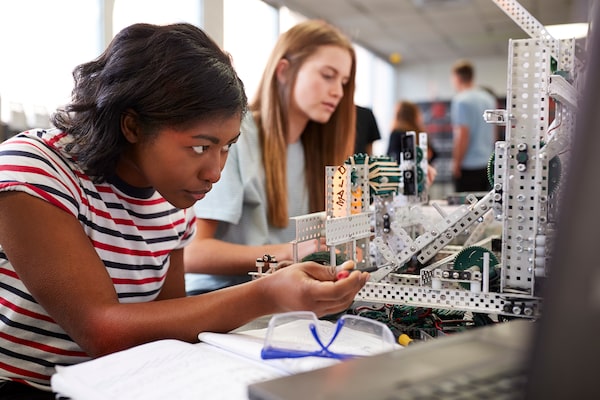
Making STEM relevant and accessible also helps to build inclusion and a sense of belonging for equity-deserving audiences that have historically been excluded from STEM fields, writes Bonnie Schmidt.iStockPhoto / Getty Images
Let’s Talk Science and the Royal Society of Canada have partnered to provide Globe and Mail readers with relevant coverage about issues that affect us all – from education to the impact of leading-edge scientific discoveries.
Bonnie Schmidt, CM, PhD, FRSC the President & Founder of Let’s Talk Science
It’s rare to see almost complete agreement on anything these days, but a recent poll by Let’s Talk Science found that 95% of adults believe that it is important or very important for youth to have a good STEM (science, technology, engineering and math) education for future work and to help them make good decisions as citizens about the country’s future. The last two years have also demonstrated the importance of STEM and scientific literacy in responding to the COVID-19 pandemic, tackling climate change, and addressing many other pressing global issues.
Given that, why, then, do most high school students still drop STEM subjects before graduating high school, closing doors to many university, college and skilled trades pathways? The reality is that the vision of building a diverse STEM workforce won’t be realized if current STEM participation doesn’t improve in school. Early disengagement will also contribute to a growing inability to decipher fact from fiction as misinformation spreads through social media.
The end of the school year is a great time to reflect on the past and imagine the future. Public education in Canada is a tremendous national strength. But it is also a complex ecosystem that is managed independently by every province and territory. Structured to develop people for an agricultural and early industrial economy, it has served us well over the past 155 years. This is especially true when assessed against international standards. For example, Canada has high graduation rates and students consistently perform well on international tests such as PISA. But the education ecosystem is resistant to change.
Today’s elementary and secondary students need to prepare for a vastly different, and increasingly unpredictable, future. The need for change is understood across the education ecosystem but it is difficult to enact at scale. Tremendous local innovation is being led by talented educators and community organizations across Canada. We need to do more to scale successes - and provoke many more! One way to catalyze change in secondary school, for example, would be to change post-secondary admission requirements, which continue to centre on students completing traditional, pure science courses in high school.
The pace of knowledge generation has exploded. It’s time to radically rethink curriculum across Canada and embrace a multi-disciplinary approach, engaging students in tackling real problems, building critical skills and characteristics. This would result in engaged learners who are inspired to solve problems and it would be more reflective of how we live and how we ‘do science’. It is possible. Saskatchewan has replaced traditional Grade 11 pure science courses with multi-disciplinary courses on climate, water and health, weaving traditional scientific principles throughout these issues-based courses. However, these courses are not offered in Grade 12 because of constraints imposed by post-secondary admissions.
In Ontario, the Halton District School Board launched the integrated iSTEM program starting with Grade 9. Students in this four-year program develop innovation skills related to engineering design and design thinking, ‘intrepreneurial thinking skills’ and global competencies. The first cohort has yet to graduate from high school but outcomes to date are very promising.
There are many other examples of innovation across the country. The charitable organization I founded, Let’s Talk Science, has evolved significantly over the last 30 years. We offer a suite of programming (no cost to participants) that includes in-person and virtual learning opportunities. We also catalyze connections between the science, technology and innovation community and schools, tackling key barriers to youth engagement and building career awareness. Making STEM relevant and accessible also helps to build inclusion and a sense of belonging for equity-deserving audiences that have historically been excluded from STEM fields.
Let’s Talk Science has launched effective new virtual programming for youth and educators. It was possible because most schools do have internet access. However, many youth don’t have access to affordable and reliable Internet or the technology to use it outside school. If left unaddressed, the equity gap will continue to widen as technology-enabled learning continues to evolve.
If we don’t shape the change ourselves, global pressures may impose it on us – or leave us behind. In February 2020, I served on the PISA Science Experts Committee, responsible for making recommendations to reshape the international science test that is given to 15-year-old students in more than 80 countries. The test evaluates students’ ability to use their knowledge to address expected real life challenges. Our recommendations included adding challenges that involve genomics, artificial intelligence, big data, climate change, environmental systems, science identity and more. While Canada has consistently ranked highly on past PISA tests, if we want to maintain or improve, we will need to incorporate new approaches and critical fields that are impacting our daily lives into curricula. Much more important than excelling on a test, these changes will help future-ready all youth.
Public education is a core Canadian value and source of pride. Let’s be bold, catalyze change where it’s needed, and ensure that all youth are prepared to thrive.